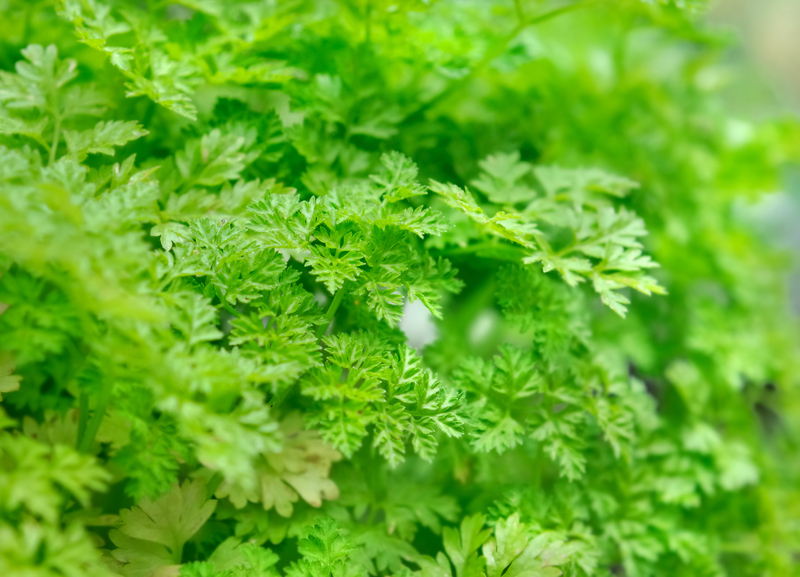Turning Kitchen Scraps into Nutrient-Dense Soil Amendments
Posted on 15/08/2025
Turning Kitchen Scraps into Nutrient-Dense Soil Amendments: A Complete Guide
Are you looking to reduce kitchen waste while boosting your garden's productivity? In this comprehensive guide, we will explore how to repurpose common kitchen scraps into powerful, nutrient-rich soil amendments. By turning food leftovers into garden gold, you'll help the environment and elevate your soil's fertility--all with simple, sustainable practices. Let's dig into all you need to know about transforming your kitchen waste into organic nutrients for flourishing plants!

Why Transform Kitchen Scraps into Soil Amendments?
Every year, households throw away tons of food scraps--often ending up in landfills and contributing to greenhouse gas emissions. However, these kitchen leftovers hold immense potential for garden use. When recycled into the soil, they decompose, releasing essential minerals that feed microbes and plants alike. Here's why you should consider this eco-friendly gardening strategy:
- Reduces landfill waste
- Enhances soil fertility and structure
- Encourages a healthy ecosystem in your garden
- Saves money on store-bought fertilizers
- Promotes sustainable living
Understanding Nutrient-Dense Soil Amendments
Before diving into practical methods, let's clarify what nutrient-dense soil amendments are. Soil amendments are any substances added to the soil to improve its physical or chemical properties. Kitchen waste--when processed properly--becomes rich in nutrients like nitrogen, phosphorus, potassium, calcium, and magnesium, all vital for plant health and productivity.
Not all kitchen scraps are equal, though. Some break down quickly, releasing nutrients, while others need more processing. Learning which scraps deliver the biggest boost is key to nurturing thriving vegetation.
Different Methods for Turning Kitchen Leftovers into Rich Soil Additives
1. Traditional Composting
Composting is perhaps the most well-known way to recycle food scraps. By combining organic kitchen waste with yard debris, homeowners can create crumbly, humus-rich compost to enhance garden beds.
How Does Composting Work?
- Microorganisms (bacteria and fungi) break down organic material.
- Worms and insects help decompose matter faster.
- Heat accelerates the natural breakdown process.
- Moisture and aeration ensure proper decomposition.
Best Kitchen Scraps for the Compost Bin
- Fruit and vegetable peels
- Coffee grounds and filters
- Eggshells
- Tea bags (check for plastic content)
- Stale bread, rice, and pasta (in moderation)
- Nut shells (except walnut shells, which can be toxic)
Avoid composting meat, dairy, oils, and heavily processed foods as they attract pests and may introduce harmful pathogens.
Composting Tips for Maximizing Nutrient Content
- Shred large scraps for faster breakdown.
- Alternate green (nitrogen) and brown (carbon) materials for optimal balance.
- Turn the pile regularly to boost aeration.
- Keep it moist--not soggy.
2. Vermicomposting: Feeding Kitchen Scraps to Worms
Vermicomposting is the process of using red wiggler worms to eat through your organic leftovers and transform them into "worm castings," a concentrated, nutrient-rich soil amendment. These castings are loaded with bioavailable nutrients for plants.
Setting Up a Vermicompost Bin
- Get a ventilated container (wood, plastic, or metal).
- Add a bedding of shredded newspaper, cardboard, and a bit of soil.
- Introduce a colony of red wiggler worms.
- Add kitchen scraps--fruit, veggies, crushed eggshell, coffee grounds.
- Keep the bedding moist and the bin out of extreme sunlight or freezing temps.
Worm castings can be mixed into seed-starting soil or used directly around garden plants for a slow-release boost.
3. Bokashi Composting: Fermenting Kitchen Waste
The Bokashi method uses beneficial microbes to ferment kitchen scraps--even items like meat and dairy that can't go in regular compost. The result is a pre-compost that can be buried in the garden to rapidly finish decomposition, producing a nutrient-dense amendment.
How Bokashi Works
- Scraps are layered in an airtight bin with Bokashi bran (inoculated with microbes).
- The airtight environment ferments, rather than rots, the food.
- After two weeks, the pickled matter is buried in garden soil to complete decomposition.
*Bokashi is great for urban gardeners or those with small spaces as it produces minimal odor and handles many types of food waste.*
4. Direct Burying of Kitchen Scraps
Some gardeners skip formal composting equipment by burying small amounts of kitchen waste directly in the soil. This method is simple, requires no container, and introduces nutrients directly to plant roots.
How to Bury Scraps Effectively:
- Dig a hole or trench at least 8 inches deep.
- Add a layer of chopped food scraps.
- Cover completely with soil to prevent pests.
- Wait a few weeks before planting over the area.
Direct burying is best for vegetable peels, fruit cores, coffee grounds, and eggshells. Avoid meats and dairy.
Nutritional Benefits of Kitchen Scrap Soil Amendments
How do kitchen scraps enhance soil quality? Each type of leftover delivers unique minerals and organic matter that replenish garden beds with essential nutrients. Here's what some common scraps contribute:
- Fruit and Vegetable Peels: Supply potassium, phosphorus, and micronutrients.
- Coffee Grounds: Add nitrogen, boost soil acidity for acid-loving plants, and repel pests when spread on the soil surface.
- Eggshells: Release calcium--vital for preventing tomato blossom-end rot and strengthening cell walls in plants.
- Banana Peels: Rich in potassium, magnesium, and traces of phosphorus, perfect for flowering and fruiting plants.
- Tea Leaves: Increase nitrogen and help condition the soil.
- Nut Shells: Offer slow-release nutrients and improve soil aeration.
These organic amendments don't just feed plants directly--they support beneficial microbes and enhance soil structure, allowing for better root growth and moisture retention.
How to Apply Homemade Kitchen Scrap Amendments in the Garden
Now that you've created your nutrient-rich amendments, how can you best use them for optimal plant health?
Incorporating Compost Into Garden Beds
- Top Dress: Spread 1-3 inches of mature compost over garden beds in early spring or fall.
- Mix In: Blend compost into the top 6 inches of soil before planting.
- Transplant Holes: Add a scoop to planting holes for veggies and flowers.
- Lawn Boost: Scatter a thin layer over lawns to enhance grass vitality.
Using Vermicompost (Worm Castings)
- Seed Starting: Blend with potting mix for healthy seedlings.
- Mulching: Place around the base of existing plants for a nutrient drip feed.
- Liquid Fertilizer: Brew worm tea by steeping castings in non-chlorinated water for several hours, then use as a foliar spray or soil drench.
Bokashi Pre-Compst
- Bury fermented matter in garden beds away from roots or sowing areas.
- Allow 2-4 weeks for decomposition before planting directly above.
Tips to Maximize Safety and Effectiveness
- Chop or shred scraps for faster breakdown and nutrient release.
- Avoid diseased plant material in compost to minimize disease risk to new crops.
- Monitor moisture levels in compost bins; overly wet or dry conditions slow decomposition.
- Use only plant-based materials for direct trenching; animal products should be composted or fermented to avoid pests.
- Rotate amendment locations so soil nutrients remain balanced across your garden.
Common Questions About Kitchen Scrap Amendments
Is Compost from Kitchen Scraps Safe for Edibles?
Yes, as long as compost is fully matured and properly managed (hot composted or vermicomposted), it offers safe nutrition for vegetables, fruits, and herbs. Incomplete decomposition, especially from poorly managed piles, can harbor pathogens--so patience is key.
How Long Does It Take for Food Scraps to Become Plant Food?
- Traditional compost: 2-6 months, depending on conditions.
- Vermicompost: 2-4 months.
- Bokashi-emended soil: 2-4 weeks after burial.
- Direct buried scraps: 2-6 months to fully break down, longer in cold climates.
Do Kitchen Scrap Amendments Attract Pests?
They can unless you use good practices: cover food wastes well in compost or trenches, avoid adding meat/fats openly to piles, and keep bins secured. Bokashi systems, being airtight, are virtually pest-resistant.

Going Beyond the Basics: Creative Ways to Reuse Specific Scraps
- Citrus Peels: Avoid in worm bins but can be dried, chopped, and scattered around plants to deter slugs and ants.
- Avocado Skins and Pits: Take longer to break down but add gritty texture and micronutrients to compost.
- Onion and Garlic Skins: Rich in sulfur, can be soaked in water and used as a pest-repelling foliar spray.
- Crushed Eggshells: Sprinkle around tomato plants directly to add calcium and deter slugs.
Sustainable Gardening Starts in the Kitchen
By turning kitchen scraps into nutrient-dense soil amendments, you not only create a closed-loop system for food and gardening waste, but also unlock healthier, more vibrant plants without synthetic chemicals. Whether you choose composting, vermiculture, bokashi, or trench methods, the result is lively, robust soil bursting with life.
Start today: Set aside your kitchen leftovers, choose a method that fits your lifestyle, and watch your garden thrive with eco-friendly, homegrown plant food!
- Reduce waste
- Revitalize your soil
- Grow stronger, healthier plants
With consistent effort, you'll transform everyday discards into an essential resource for sustainable gardening success. Your kitchen scraps can be the secret weapon for vibrant, productive gardens--naturally!



